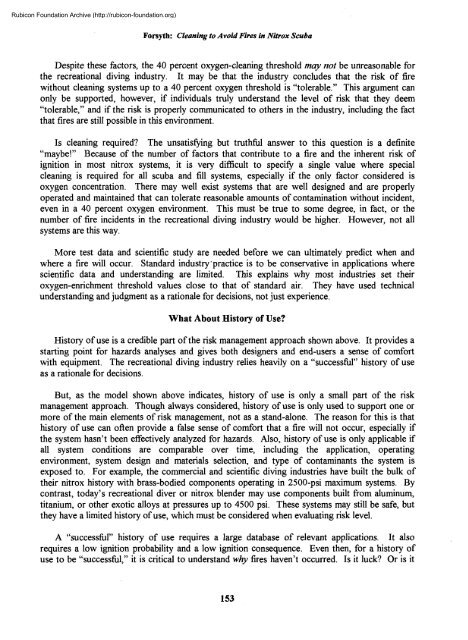Nitrox workshop dings - Divers Alert Network
Nitrox workshop dings - Divers Alert Network
Nitrox workshop dings - Divers Alert Network
Create successful ePaper yourself
Turn your PDF publications into a flip-book with our unique Google optimized e-Paper software.
Rubicon Foundation Archive (http://rubicon-foundation.org)Forsyth: Cleaning to Avoid Fires in <strong>Nitrox</strong> ScubaDespite these factors, the 40 percent oxygen-cleaning threshold may not be unreasonable forthe recreational diving industry. It may be that the industry concludes that the risk of firewithout cleaning systems up to a 40 percent oxygen threshold is "tolerable." This argument canonly be supported, however, if individuals truly understand the level of risk that they deem"tolerable," and if the risk is properly communicated to others in the industry, including the factthat fires are still possible in this environment.Is cleaning required? The unsatisfying but truthful answer to this question is a definite"maybe!" Because of the number of factors that contribute to a fire and the inherent risk ofignition in most nitrox systems, it is very difficult to specify a single value where specialcleaning is required for all scuba and fill systems, especially if the only factor considered isoxygen concentration. There may well exist systems that are well designed and are properlyoperated and maintained that can tolerate reasonable amounts of contamination without incident,even in a 40 percent oxygen environment. This must be true to some degree, in fact, or thenumber of fire incidents in the recreational diving industry would be higher. However, not allsystems are this way.More test data and scientific study are needed before we can ultimately predict when andwhere a fire will occur. Standard industry practice is to be conservative in applications wherescientific data and understanding are limited. This explains why most industries set theiroxygen-enrichment threshold values close to that of standard air. They have used technicalunderstanding and judgment as a rationale for decisions, not just experience.What About History of Use?History of use is a credible part of the risk management approach shown above. It provides astarting point for hazards analyses and gives both designers and end-users a sense of comfortwith equipment. The recreational diving industry relies heavily on a "successful" history of useas a rationale for decisions.But, as the model shown above indicates, history of use is only a small part of the riskmanagement approach. Though always considered, history of use is only used to support one ormore of the main elements of risk management, not as a stand-alone. The reason for this is thathistory of use can often provide a false sense of comfort that a fire will not occur, especially ifthe system hasn't been effectively analyzed for hazards. Also, history of use is only applicable ifall system conditions are comparable over time, including the application, operatingenvironment, system design and materials selection, and type of contaminants the system isexposed to. For example, the commercial and scientific diving industries have built the bulk oftheir nitrox history with brass-bodied components operating in 2500-psi maximum systems. Bycontrast, today's recreational diver or nitrox blender may use components built from aluminum,titanium, or other exotic alloys at pressures up to 4500 psi. These systems may still be safe, butthey have a limited history of use, which must be considered when evaluating risk level.A "successful" history of use requires a large database of relevant applications. It alsorequires a low ignition probability and a low ignition consequence. Even then, for a history ofuse to be "successful," it is critical to understand why fires haven't occurred. Is it luck? Or is it153
















